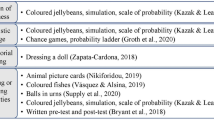Abstract
In this article, we discuss the complexity of geometric proofs with respect to a theoretical analysis and empirical results from studies in Taiwan and Germany. Based on these findings in both countries, specific teachings experiments with junior high school students were developed, conducted, and evaluated. According to the different classroom and learning culture in East Asia and Western Europe, the interventions differed in their way of organizing the learning activities during regular mathematics lessons. The statistical analysis of the pre–post-test data indicated that both interventions were successful in fostering students’ proof competence.


Similar content being viewed by others
Notes
The German Gymnasium is the high attaining school track in Germany preparing students for the university. It encompasses about 40% of the students of one year and starts in grade 5. In the other school tracks, proof does not play a significant role in mathematics lessons.
All tests used in Germany and in Taiwan are based on the same competency model. Moreover, there are common items for the tests in both countries, but the tests for the different grades are not identical.
In fact, based on anchor items, all items of the different tests can be arranged on a common one-dimensional Rasch scale, such that there is quite a good basis for a comparison of the different grades.
A short version of a worked-out example is given in the appendix of the electronic version of this article.
References
Boero, P. (1999). Argumentation and mathematical proof: a complex, productive, unavoidable relationship in mathematics and mathematics education. International newsletter on the teaching and learning of mathematical proof 7/8. http://www.lettredelapreuve.it. Accessed 11 Feb 2008.
Cabassut, R. (2005). Argumentation and proof in examples taken from French and German textbooks. In: M. Bosch (Ed.), Proceedings of the Fourth Congress of the European Society for Research in Mathematics Education (pp. 391–400). http://ermeweb.free.fr/CERME4/. Accessed 11 Feb 2008.
Duval, R. (2002). Proof understanding in mathematics: what ways for students? Plenary paper at the “International Conference on Mathematics: Understanding proving and proving to understand”. Department of Mathematics, National Taiwan Normal University, Taipei, 16–19 November 2002.
Healy, L., & Hoyles, C. (1998). Justifying and proving in school mathematics. Technical report on the nationwide survey. Institute of Education, University of London.
Heinze, A., & Reiss, K. (2004). The teaching of proof at lower secondary level––a video study. Zentralblatt für Didaktik der Mathematik (ZDM), 36(3), 98–104.
Heinze, A., Cheng, Y.-H., & Yang, K.-L. (2004). Students’ performance in reasoning and proof in Taiwan and Germany: Results, paradoxes and open questions. Zentralblatt für Didaktik der Mathematik (ZDM), 36(5), 162–171.
Heinze, A., Reiss, K., & Rudolph, F. (2005). Mathematics achievement and interest in mathematics from a differential perspective. Zentralblatt für Didaktik der Mathematik (ZDM), 37(3), 212–220.
Herbst, P. (2002). Engaging students in proving: a double bind on the teacher. Journal for Research in Mathematics Education, 33(3), S. 176–S. 203.
Lin, F. L., Cheng, Y.-H., et al. (2003). The competence of geometric argument in Taiwan adolescents. International Conference on Science & Mathematics Learning. Department of Mathematics, National Taiwan Normal University, Taipei, 16–18 December 2003.
Reiss, K., & Heinze, A. (2004). Knowledge acquisition in students’ argumentation and proof processes. In: G. Törner, R. Bruder, A. Peter-Koop, N. Neill, H.-G. Weigand, & B. Wollring (Hrsg.), Developments in Mathematic Education in Germany. Selected Papers from the Annual Conference on Didactics of Mathematics, Ludwigsburg 2001 (pp. 107–115). Göttingen: Universitätsbilbiothek.
Reiss, K., & Renkl, A. (2002). Learning to prove: The idea of heuristic examples. Zentralblatt für Didaktik der Mathematik, 34(1), 29–35.
Reiss, K., Heinze, A., Kessler, S., Rudolph-Albert, F., & Renkl, A. (2007). Fostering argumentation and proof competencies in the mathematics classroom. In: M. Prenzel (Ed.), Studies on the educational quality of schools. The final report on the DFG Priority Programme (pp. 251–264). Münster: Waxmann.
Schoenfeld, A. (1983). Episodes and executive decisions in mathematical problem-solving. In: R. Lesh, & M. Landau (Eds.), Acquisition of mathematics concepts and processes (pp. 345–395). New York: Academic Press.
Sweller, J. (1994). Cognitive load, learning difficulty, and instructional design. Learning and Instruction 4, 295–312.
Sweller, J., van Merriënboer, J. J. G., & Paas, F. G. W. C. (1998). Cognitive architecture and instructional design. Educational Psychology Review, 10, 251–296.
Tabachneck, H. J. M., & Simon, H. A. (1996). Alternative representations of instructional material. In: D. Peterson (Ed.), Alternative representations: an interdisciplinary theme in cognitive science (pp. 28–46). London: Intellect Books.
Vinner, S. (1991). The role of definitions in teaching and learning of mathematics. In: D. Tall (Ed.), Advanced mathematical thinking (pp. 65–81). Dordrecht: Kluwer.
Acknowledgments
We are grateful to the support of the National Science Council (NSC), Taiwan (Project number 93/94/95-2521-S-163 -001), German Research Foundation (DFG), Germany (AZ: RE1247/4), and the Center for Teacher Education of the University of Munich (Germany).
Author information
Authors and Affiliations
Corresponding author
Electronic supplementary material
Below is the link to the electronic supplementary material.
Rights and permissions
About this article
Cite this article
Heinze, A., Cheng, YH., Ufer, S. et al. Strategies to foster students’ competencies in constructing multi-steps geometric proofs: teaching experiments in Taiwan and Germany. ZDM Mathematics Education 40, 443–453 (2008). https://doi.org/10.1007/s11858-008-0092-1
Accepted:
Published:
Issue Date:
DOI: https://doi.org/10.1007/s11858-008-0092-1




